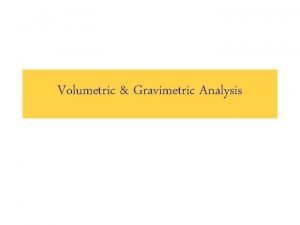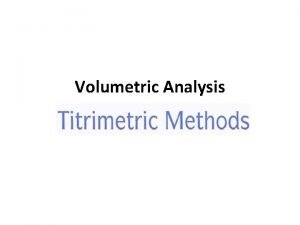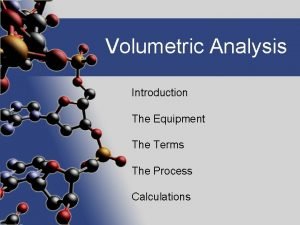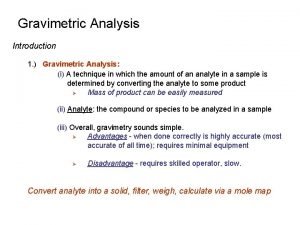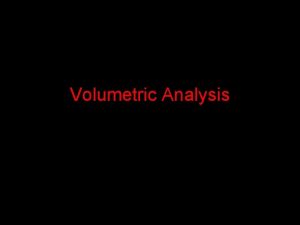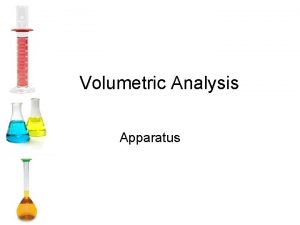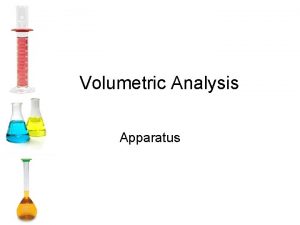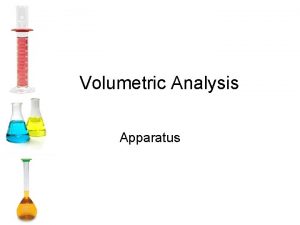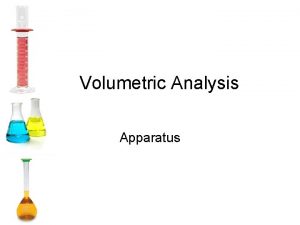Volumetric analysis To understand volumetric analysis we must



![Hydrogen exponent : p. H = log [H+] i. e. If [H+] = 10 Hydrogen exponent : p. H = log [H+] i. e. If [H+] = 10](https://slidetodoc.com/presentation_image_h2/5428488c3f82588c427328d1ca38f8b0/image-4.jpg)



- Slides: 7

Volumetric analysis To understand volumetric analysis, we must understand the types of reaction that happen in it. Types of reactions used in volumetric analysis : I- Ionic combination reactions: The reaction goes to completion due to formation of slightly ionizable or slightly insoluble products. a- Neutralization reaction : In which acid reacts with base to form slightly ionized water. H+ + OH b- Formation of precipitate : Ag+ + Cl H 2 O Ag. Cl c- Formation of slightly ionizable complex : Ag+ + 2 CN Ca+2 + H 2 Y 2 [EDTA] [Ag(CN)2] 2 H+ + Ca. Y 2 [Ca EDTA complex] II- Electron transfer reactions : In which electron transfer from one reactant to another. It is called (oxidation reduction reactions) Ce+4 + Fe+2 Ce+3 + Fe+3 i. e. Fe+2 Ce+4 + e Fe+3 + e Ce+3 oxidation (loss of es. ) reduction (gain of es)

Acid-Base Acid- base theories 1 - Arrhenius theory : Acid : Is the substance which ionize to give H+ Base : Is the substance which ionize to give OH eg. HCl eg Na. OH 2 - Bronsted - Lowry theory : Acid : Is the substance which donate proton. Base : Is the substance which accept proton. Every acid has a conjugate base and the base has conjugate acid. The stronger the acid the weaker its conjugate base and vice versa. Eg. HCl + Acid H 2 O base Eg. NH 3 + base H 2 O acid N. B. Cl + conj. base NH 4+ + conj. acid H 3 O+ conj. acid OH conj. base Water behave as acid or base because it is neutral.

3 - Lewis theory : Acid : Is substance which accept lone pair of electrons eg. BF 3, Al. Cl 3. Base : Is substance which donate lone pair of electrons eg NH 3, amines. Acid-base titration in aq. medium Solns. are classified into : Electrolytes : Which desociate (ionize) and conduct electricity. or Non electrolytes : Which doesn't ionize and doesn't conduct electricity. Dissociation of water H 2 O H+ + OH Dissociation const. Kw = [ H+] [OH ] / [H 2 O] Since H 2 O is weakly dissociated , therfore H 2 O is considered unity. therfore Kw = [H+] [OH ] = 10 14 at 25 oc Kw : it is called ionic product of water. At 25 oc [H+] =[OH ] = 10 7 If [H+] = [OH ] , therfore soln. is neutral If [H+] > 10 7 eg 10 6, 10 5 , therfore soln. is acidic If [H+] < 10 7 eg 10 8, 10 9 , therfore soln. is alkaline.
![Hydrogen exponent p H log H i e If H 10 Hydrogen exponent : p. H = log [H+] i. e. If [H+] = 10](https://slidetodoc.com/presentation_image_h2/5428488c3f82588c427328d1ca38f8b0/image-4.jpg)
Hydrogen exponent : p. H = log [H+] i. e. If [H+] = 10 7 p. H = log 10 7 = 7 In acidic side i. e. If [H+] = 10 6 p. H = log 10 6 = 6 In basic side i. e. If [H+] = 10 8 p. H = log 10 8 = 8 i. e. as p. H value inc. [H+] conc. decrease. Therefore acid soln has p. H less than 7 , alkaline soln. has p. H more than 7 and neutral soln. has p. H = p OH = 7 p. H of acid and bases : 1 - p. H of strong acids : Since strong acids are strongly ionized. Therfore p. H = p. Ca where Ca ( conc. of acid) i. e. 0. 1 N HCl p. H = log 0. 1= log 10 1 = 1 2 - p. H of strong bases : Since strong bases are completely ionized. Therfore p OH = p Cb where Cb (conc. of base) p. H = p Kw – p OH i. e. p. H = p Kw – p Cb. i. e. 0. 1 N Na. OH p. H = 14 _ 1 = 13 3 - p. H of weak acids : p. H = 1/2 p. Ca + 1/2 p. Ka 4 - p. H of weak bases : p. H =p. Kw - 1/2 p. Cb - 1/2 p. Kb

5 - p. H of salts : a- Salt of strong acid and strong base eg. Na. Cl Always neutral i. e. p. H = 7 b- Salt of strong acid and weak base eg. NH 4 Cl Always p. H is in the acidic side , calculated from eq. p. H = 1/2 p. Kw - 1/2 p. Kb + 1/2 p. Cs where Kb (dissociation constant of weak base) Cs (conc. of salt) c- Salt of weak acid and strong base eg. Na Ac Always p. H is in the alkaline side, calculated from eq. : p. H = 1/2 p. Kw + 1/2 p. Ka - 1/2 p. Cs where Ka (dissociation constant of weak acid) Cs (conc. of salt) d- Salt of weak acid and weak base eg. NH 4 Ac p. H is calculated from eq. : p. H = 1/2 p. Kw + 1/2 p. Ka - 1/2 p. Kb Buffer solutions Def : They are solns which resist changes in p. H upon addition of small amount of acid or base. They consist of weak acid and its salt or weak base and its salt Type 1 - weak acid and its salt eg. HAc and Na Ac p. H of this buffer is calculated from the eq. : p. H = p. Ka + log salt / acid

Type 2 - weak base and its salt eg. NH 4 OH and NH 4 Cl p. H of this buffer is calculated from the eq. : p. H = p. Kw - p. Kb - log salt/base log salt/acid or log salt/base is called buffer ratio if [salt] = [acid] therefore p. H =p. Ka Examples 1 Calculate the p. H of a buffer soln. containing 0. 1 M acetic acid and 0. 1 M sodium acetate p. Ka =4. 76 soln. p. H = p. Ka + log salt / acid p. H = 4. 76 + log 0. 1 / 0. 1 = 4. 76 Neutralization indicators Color indicators: Substance which change their color with change in p. H are used as neutralization indicators. eg. phenol phthalein"Ph. Ph" (one color indicator), methyl orange"M. O" (2 color indicator) eg. Ph. =8 10 M. O. =3. 3 4. 4 M. R. = 4 6 N. B. the indicator is chosen according to p. H of the product.

Neutralization titration curves For neutralization reaction titration. The titration curve is plot of p. H versus the mls of titrant. Types of neutralization curves: 1 - Strong acid -strong base titration : eg. HCl and Na. OH we have sample of 100 ml HCl and titrate against Na. OH. a. Before the titration p. H is due to the sample i. e HCl (strong acid) therfore p. H = p. Ca b At the equivalent point : HCl +Na. OH Na. Cl + H 2 O p. H is due to Na. Cl i. e. p. H= 7 (salt of strong acid and strong base) c After the equivalent point : p. H is due to excess titrant i. e. Na. OH (strong base) p. H = p. Kw p. Cb N. B. The p. H rises slowly till 99. 9 % of acid is titrated by adding 0. 1 ml Na. OH p. H rises from 4 to 7 then another 0. 1 ml after end point p. H rises from 7 to 10 i. e. at e. p. p. H rises from 4 to 10. So we can use M. O. (3. 3 4. 4) M. R. (4 6) Ph. (8 10) indicators


